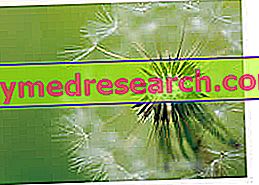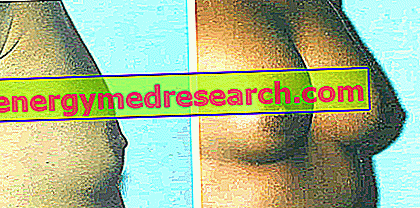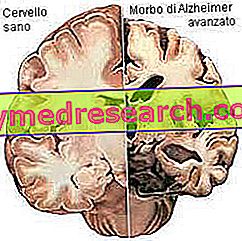Allergy to pollen
Pollinosis is an allergy with a typical seasonal recurrence. The allergic reaction that traces it is stimulated and induced by pollens that possess peculiar characteristics: they are harmless to most subjects, cause of allergy for a small slice of the population.

Possible complications are asthma or asthmatic bronchitis, nasal polyposis and sinusitis.
Prevention
Environmental preventive measures are difficult to implement: there is no effective way to avoid the disease, since it is not possible to completely prevent exposure to antigenic pollen dispersed in the biological aerosol. Before the start of the pollen season, the patient should contact the allergist, to set the most appropriate preventive or therapeutic program. In fact, we can try to limit the manifestation of symptoms, avoiding the causes that trigger allergic reactions and taking some measures to reduce exposure to allergenic antigens.
In this regard, it is worth considering that:
- The diagnostic investigations allow to identify exactly the allergenic antigen: the chemical and / or molecular characterization allows to identify the botanical species (herbs, flowers or trees) to which the pollen that causes the allergy belongs.
- The etiological and symptomatic approach being diagnosed allows us to know which factors and habits contribute to triggering the pollinosis (example: seasonality of the symptoms, the way in which the allergy occurs, activities that were taking place when the first occurred attack etc.). In this way it is possible to adopt behavioral and preventive measures to avoid the allergic reaction.
- Drug therapy is essential for pollen allergy, because it controls symptoms and improves quality of life . Pollen allergy tends to be chronic: for this reason, long-term management strategies of the disease must be proposed to the patient.
- Aerobiological monitoring monitors air quality, aimed at measuring the atmospheric concentration of the main allergenic pollens. The evaluation of the responsible pollen component dispersed in the air becomes concrete with the flowering calendars (or pollen bulletin), which can provide the patient with an important support for the clinical management of allergy. The allergic subject can be updated in real time on the specific pollination period, on the potential exposure to the allergen and, on medical indication, can resort to the correct preventive or symptomatic pharmacological therapy.
Useful tips
In addition to specific pharmacological therapies, it is possible to use a series of strategies that allow, in a simple and effective way, to keep pollen allergy under control:
- Consult the flowering calendars to find out the pollination period of the plant to which you are allergic. The flowering period of the different varieties of pollen changes at the territorial level and, in general, in the plains occurs before in the mountains. This information allows a correct approach to preventive or pharmacological therapy: if a high concentration of pollen is expected in the atmosphere, it is advisable to start taking the drugs for allergy before the onset of symptoms. Furthermore, the symptoms may increase in proportion to the quantity and quality of pollen grains dispersed in the biological aerosol.
- Don't walk in fields, meadows or gardens where the grass has been recently cut . During the pollination period, avoid sports activities near green areas.
- Remember that pollen concentrations are higher on dry, windy and sunny days.
- Between 10 am and 4 pm, the period of greatest concentration of pollens, keeping the windows and windows of the car closed and avoiding outdoor activities or walks in the countryside.
- At home and in the office, if possible, use air conditioners or anion generators, which lower the concentration of pollen. To reduce allergens, pay attention to cleaning the house and possibly use a vacuum cleaner with a HEPA filter.
- If the car has air conditioning, install a pollen filter (to be cleaned often and replaced at each service).
- Use appropriate dust masks when working outdoors. During periods of maximum pollination, avoid dedicating yourself to gardening.
- During the day, outdoors, it is useful to wear a pair of dark glasses: sunlight increases the discomfort associated with eye symptoms.
- Before choosing the location and the periods for the holidays, it is advisable to inquire about the possible presence of allergens. In the acute phase of allergy, if possible, spend some time at the sea, a poorly saturated pollen environment. Those who are allergic to the parietaria must prefer the mountain: the plant does not grow above 1, 000 m altitude, while it grows on coastal areas.
- When you come back home take a shower, wash your hair and change clothes to eliminate pollens that have become attached during the day, thus avoiding exposure to the allergen at night. Even pets can "spread" the pollen grains with their fur: they should be avoided if they are placed on the bed or on the sofa.
- Do not hang laundry outdoors: pollen can stick to sheets and towels.
- Do not consume alcohol: alcoholic beverages stimulate mucus production and dilate vessels, worsening nasal discharge and congestion. Avoid smoking: smoking further irritates the mucous membranes of the nose and eyes.
- Several pollens contain antigens common to some plant foods. In allergic subjects, unexpected reactions (itching, swelling of the lips and oral cavity) may occur, at the time these foods are ingested, during the pollination season. These symptoms constitute the oral allergic syndrome (SOA). To avoid the onset of cross-reactivity due to the botanical "kinship" between pollen and some plant families, it is important to identify the allergenic components in common and avoid incorporating certain foods into one's diet.
Natural remedies
Herbal remedies and dietary supplements can support the symptomatic treatment of pollen allergy. Here is a short list of the main natural products that help alleviate the effects of the disease:
- Perilla ( Perilla frutescens )
Properties of the phytocomplex : antiallergic and immunomodulator.
Therapeutic use : useful in inflammatory disorders, including allergies to different antigens; Relieves symptoms of allergic rhinitis and may be suitable for the prevention of bronchial asthma. It inhibits the most important chemical mediators involved in inflammation and allergy, such as histamine and leukotrienes. Reduces IgE levels. Its ability to mitigate allergic disorders of various kinds (such as asthma, rhinitis, urticaria, dermatitis and eczema etc.) has been scientifically confirmed.
- Black currant ( Ribes nigrum )
Properties of the phytocomplex : anti-inflammatory (with effect similar to cortisone, but without the same toxicity profile), antihistamine and analgesic.
Therapeutic use : its cortisone-like activity is exerted at the level of the cortex of the adrenal glands and stimulates the secretion of substances with an anti-inflammatory action. It has a specific anti-allergic action: it is indicated against hay fever, conjunctivitis and allergic bronchitis.
If some signs of allergy, such as dry cough and hoarseness, tend to persist, Blackcurrant may be associated with Rosa canina .
- Rosa canina ( Rosa Canina )
Properties of the phytocomplex : anti-inflammatory and antioxidant.
Therapeutic use : it plays an important role in acute phlogosis which involves alterations of the mucous membranes, especially when they are associated with allergic-asthmatic components. For these properties it is an important remedy in the prevention of respiratory allergies. Furthermore, the fruits of the Rosa Canina are a source of concentrated Vitamin C, able to contribute to the strengthening of the body's natural defenses.
- Adatoda ( Adhatoda Vasica )
Properties of the phytocomplex : bronchodilator, antihistamine, expectorant-mucolytic and antiseptic.
Therapeutic use : helps to breathe better in case of cough, acute and chronic bronchitis and relieves allergic manifestations affecting the respiratory system.
Other herbal remedies may include:
- Boswellia ( Boswellia serrata ) : its resin contains boswellic acids, which inhibit some enzymes (5-lipoxygenase) thus blocking the synthesis of leukotrienes, involved in inflammatory processes typical of immunological and allergic reactions.
- Noni ( Morinda citrifolia ) : the juice reduces inflammation and strengthens the immune system; the dry extract is very useful in treating the consequences of allergic rhinitis.
- Licorice ( Glycyrrhiza glabra ) : is an effective immunomodulator and an inhibitor of histamine release.
- Oligotherapy, on the other hand , includes the association of Manganese, Sulfur and Phosphorus for seasonal allergies, with allergic manifestations such as rhinitis, conjunctivitis, etc. These elements, taken during the period of greatest discomfort, play an important desensitizing and detoxifying action.
More advice:
- Wash your eyes often with cold water ;
- Before going to sleep, apply a cotton ball soaked with chamomile and rosemary infusion on the eyelids;
- During periods of exacerbation of pollen allergy symptoms, adopt a detoxifying diet for several consecutive days, trying to vary the diet often.
Food tips
| Which foods do you prefer: | |
onions | They contain sulfur compounds that inhibit the allergic and inflammatory response. They purify the intestine, contain vitamin C and mineral salts. |
Foods rich in magnesium (whole grains, beans, green leafy vegetables, bananas, etc.) | Magnesium helps to minimize histamine production. |
Foods with high vitamin C content | They support the regular function of the immune system. |
What foods to avoid: | |
In addition to avoiding certain foods that can cause cross-reactivity with pollens, it is useful to limit the consumption of foods that stimulate the release of histamine : strawberries, tomatoes, chocolate, crustaceans, molluscs, fermented cheeses, sausages and dried fruit. The consumption of milk and dairy products can cause mucus hypersecretion, which aggravates the symptoms of allergic rhinitis and asthma. Also avoid: generally fatty foods and sugar. | |



